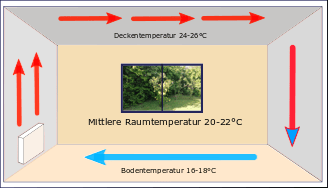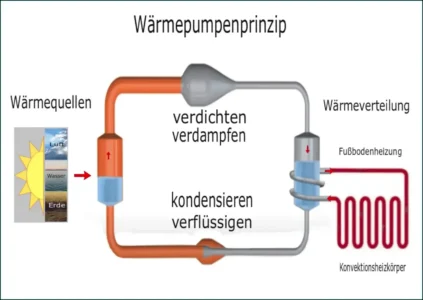We are currently experiencing a hype regarding the use of Heat pump heaters. . Since they are exceptionally expensive, it is worth taking a look at this technology.
From a physical and technical point of view, this is convection heating, which has been in use since time immemorial. Convection heating physically utilises thermodynamics to distribute the heat generated in the room. This basic principle has considerable shortcomings in terms of efficiency. The energy losses that occur are no longer acceptable given today's fuel prices, yet heat pump heating is still recommended to the public due to a lack of technical knowledge.
However, due to its superior technology, the more modern heating technology of infrared radiation heating, which is based on quantum physics, is increasingly coming into focus in new builds and renovations of
This happens when a building owner or specialist planner questions the myth that you can get 3-5 times the energy you put in as heat out again with a heat pump heating system. If that were the case, all the world's energy problems would be solved in one fell swoop. This statement violates the first and second laws of thermodynamics and is therefore not possible. That is why no one has managed to build a perpetual motion machine for many centuries.
Also liebe Leser – keine Märchen von Politikern, Journalisten oder (leider auch) Energieberatern glauben, sondern Informieren und Nachdenken!
 Convection heat with the physics of thermodynamics
Convection heat with the physics of thermodynamicsIn the most common form of heating buildings to date, we generally use radiators filled with heating water, and in the case of underfloor heating, a heating pipe system laid in the floor.
Both types of heating heat the ambient air, making it lighter and rising to the ceiling. Warm air escapes upwards and cold air flows in from below.
A cycle of heat movement is created with cold air below and warm air above. This describes the movement (dynamics) and the rising heat (thermal) as thermodynamics. The temperature difference between above and below can be between 8 - 12°C, depending on the upper insulation. These are serious efficiency losses, as we do not live under the ceiling but on the floor below. In order to have sufficient heat in the room below, we have to turn the heating up further.
The calculations of the heat requirement of buildings required for convection heating systems must correctly be carried out according to the rules of thermodynamics. However, heat load calculations based on thermodynamics are incorrect for infrared heating systems. The rules of quantum mechanics apply here.
 Radiant heat with the physics of quantum mechanics
Radiant heat with the physics of quantum mechanicsInfrared heat is electromagnetic radiation in a specific wavelength range. Depending on the frequency, the resulting light particles (photons) form an invisible to white-hot heat radiation. The sun generates such radiation. It moves through space at the speed of light without any loss. The same thing happens with infrared heating elements in the room of a building.
If the radiation hits people or objects, they are heated. Some of the radiation is absorbed, the rest is reflected and travels through the room until all the energy has been used up. In this way, every person, every object and every corner of a room is reached and, at best, heated by the same energy once it has been paid for. multiple warmed!
This combination of properties represents a paradigm shift for the heating technology of the future.
The calculation formulas of the quantum physics. The discoverer and namesake is the physicist Max Planck. Around 1900, he calculated that infrared rays do not move through space as a continuous beam, but rather divided into portions (quantum). This marked the birth of the era of quantum physics with new physical principles, effects and calculations.
The physicists Stephan and Bolzmann developed the formula of the same name for calculating the radiant power of infrared heating elements. Only this and other quantum mechanics formulae may be used in any form of heat requirement or efficiency calculations for infrared heaters. If thermodynamic calculations are carried out, the results will be incorrect. Every construction expert knows that a DIN standard is not legally binding, but must always be calculated, worked and executed "according to the latest rules of technology", which is why:
Attention building physicists: if the heat load calculation is incorrect, considerable claims for damages could be formulated!
 Comparison of heat pump heating vs. infrared heating – the facts
Comparison of heat pump heating vs. infrared heating – the factsA heat pump heating system extracts thermal energy from water, earth or air and transfers it to a refrigerant. The medium vaporises and then flows into a compressor powered by electricity. This increases the pressure and therefore also the temperature. The resulting increased temperatures are then transferred to the heating system through heat exchange and channelled into the rooms via pipes and radiators. The temperature in the heating system drops again and the cycle starts again.
When you think about this system, it is difficult to understand the highly praised efficiency of heat pump heating. Cold air or water is brought into the building using an electric pump and then heated after several changes of state (a coolant is evaporated, compressed, condensed and liquefied).
Electrical energy is required for heating. Geothermal heat is always around 9°C, the air is often much colder. These temperatures must be brought to 55-65°C with convection heating and to approx. 28 - 32°C with more sensible underfloor heating.
Electrical energy is required for heating. Geothermal heat is always around 9°C, the air is often much colder. These temperatures must be brought to 55-65°C with convection heating and to approx. 28 - 32°C with a more sensible underfloor heating system, but this is not possible with an air source heat pump at low outside temperatures. The required heat must also be generated in a boiler using a hugely inefficient electric heating element.
The COP and JAZ values defined by the SHK (sanitary, heating and air conditioning) industry are not efficiency values, but are repeatedly referred to as such by energy consultants, journalists and politicians. In contrast to infrared heating, there are no standardised efficiency calculations for heat pumps.
An infrared heating system with high efficiency close to 70% cannot be beaten economically by any other heating system!


This website uses cookies to improve your experience. We'll assume you're ok with this, but you can opt-out if you wish. Read more
| Name | Domain | Purpose | Expiry | Type |
|---|---|---|---|---|
| _ga | abeg.de | Google Universal Analytics long-time unique user tracking identifier. | 2 years | HTTP |
| sbjs_migrations | abeg.de | Sourcebuster tracking cookie | 55 years | HTTP |
| sbjs_current_add | abeg.de | Sourcebuster tracking cookie | 55 years | HTTP |
| sbjs_first_add | abeg.de | Sourcebuster tracking cookie | 55 years | HTTP |
| sbjs_current | abeg.de | Sourcebuster tracking cookie | 55 years | HTTP |
| sbjs_first | abeg.de | Sourcebuster tracking cookie | 55 years | HTTP |
| sbjs_udata | abeg.de | Sourcebuster tracking cookie | 55 years | HTTP |
| sbjs_session | abeg.de | SourceBuster Tracking session | Session | HTTP |
| tk_or | abeg.de | JetPack analytical cookie that stores a randomly-generated anonymous ID. This is only used within the admin area and is used for general analytics tracking. | 5 years | HTTP |
| tk_r3d | abeg.de | JetPack analytical cookie that stores a randomly-generated anonymous ID. This is only used within the admin area and is used for general analytics tracking. | 3 days | HTTP |
| tk_lr | abeg.de | JetPack analytical cookie that stores a randomly-generated anonymous ID. This is only used within the admin area and is used for general analytics tracking. | 1 year | HTTP |
| tk_ai | abeg.de | JetPack analytical cookie that stores a randomly-generated anonymous ID. This is only used within the admin area and is used for general analytics tracking. | 5 years | HTTP |
| tk_qs | abeg.de | JetPack analytical cookie. This is used for general analytics tracking. | Session | HTTP |
| IDE | doubleclick.net | Google advertising cookie used for user tracking and ad targeting purposes. | 2 years | HTTP |
| Name | Domain | Purpose | Expiry | Type |
|---|---|---|---|---|
| __cf_bm | chatgpt.com | Generic CloudFlare functional cookie. | Session | HTTP |
| __cflb | chatgpt.com | Generic CloudFlare functional cookie. | Session | HTTP |
| Name | Domain | Purpose | Expiry | Type |
|---|---|---|---|---|
| _ga_KHX87M29Q7 | abeg.de | --- | 2 years | --- |
| _ga_DSRJTX116M | abeg.de | --- | 2 years | --- |
| _gcl_au | abeg.de | --- | 3 months | --- |
| test_cookie | doubleclick.net | Google advertising domain. | Session | HTTP |


